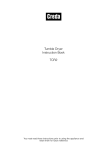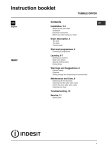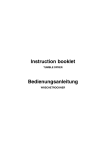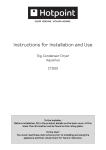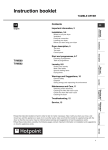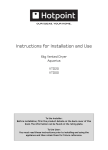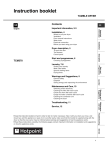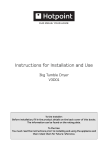Download Creda TVU1 TVR2 Troubleshooting guide
Transcript
Tumble Dryer Instruction Book TVU1 TVR2 You must read these instructions prior to using the appliance and retain them for future reference Important Information GB For your Venting dryer to operate efficiently, you must follow the regular maintenance schedule shown below: Fluff Filter... ! You MUST clean the fluff filter after EVERY drying cycle. STEP 1. Open the door of your dryer. STEP 2. Pull out the filter (using the two finger grips). STEP 4. Refit the filter. - Make sure the arrows are facing you. STEP 5. Make sure the filter is pushed fully home. - NEVER run the dryer without the filter in position. STEP 3. Clean any fluff deposits from the filter mesh. ! Failure to clean the filter after EVERY drying cycle will affect the drying performance of your machine. - It will take longer to dry and as a result will use more electricity during drying. ! You MUST clean fluff build up around the filter housing and the vent tube periodically, EVERY two or three months: - Check the vent tube and any permanent venting fixture to make sure that there has been no accumulation of fluff or lint, and remove it. - Remove lint that collects around the filter and the outlet vents. 2 Instruction booklet TUMBLE DRYER Contents GB Installation, 4-5 Where to put your dryer Ventilation Electrical connection Before you start using your dryer Dryer description, 6 The front The back Control panel Start and programmes, 7 Choosing a programme Laundry, 8-9 Sorting your laundry Wash care labels Special clothing items Drying times Warnings and Suggestions, 10 General safety Disposal Saving energy and respecting the environment Maintenance and Care, 11 Switching off the electricity Cleaning the filter after each cycle Check the drum after each cycle Cleaning the dryer Troubleshooting, 12 Service, 13 Spare parts ! Keep this instruction booklet on hand in order to refer to it when necessary. Take it with you when you move, and should you sell this appliance or pass it on to another party, make sure that this booklet is supplied along with the dryer so that the new owner may be informed about warnings and suggestions on how the appliance works. ! Read these instructions carefully; the following pages contain important information on installation and suggestions on how the appliance works. 3 Installation GB Where to put your dryer Permanent venting Place your dryer at a distance from gas ranges, stoves, heaters, or cook tops because flames can damage the appliance. ● If you are going to install the Minimum gap 10mm appliance under a work counter, be sure to leave a 10mm space between the top and any other objects on or above the machine and a 15mm space between the Minimum gaps 15mm sides and lateral furnishings or walls. This is to ensure proper air circulation. Make sure that the back vents are not obstructed. ● Make sure you put your dryer in an environment that is not damp and has proper air circulation throughout, the dryer will not operate efficiently in an enclosed space or cupboard. In conjunction with the vent tube we recommend using a Wall/Window Vent Kit, available at a retail location or the nearest Spare Parts Dealer. ● ! We do not recommend that the dryer is installed in a cupboard but the dryer must never be installed behind a lockable door, a sliding door or a door with a hinge on the opposite side to that of the dryer door. Wall mounting 1. Leave an opening in the wall to the left of the dryers proposed position. 2. Keep the tube as short and straight as possible to prevent condensed moisture from backing up into the dryer. 3. Similarly, the duct in the wall should slope downwards towards the outside. Window mounting 1. With a stacked dryer the hole in the window should ideally be made below the vent. 2. The tube should be kept as short as possible. Ventilation The Dryer dries your laundry by drawing in cool, clean and relatively dry air, heating it, and then distributing it through the clothes as they are gently tumbled. For optimum performance, the moist air is then blown out through a vent tube at the back of the dryer. When the dryer is in use, there has to be adequate ventilation to avoid the back flow of gases into the room from appliances burning other fuels, including open fires. Mobile venting A vent tube must always be fitted when the dryer is used in conjunction with Mobile Venting. The tube must be fitted securely into the back of the dryer (see Dryer Description). If possible, it is always best to connect the tube to a permanent outlet close to the dryer. If permanent installation is not possible, the dryer will work just as well with the tube passing through a partly-opened window. ! Ensure that the end of the tube is not directed toward the air intake vent at the rear of the dryer. ! The vent tube should not exceed 2.4 metres in length and should be kept free of any possible accumulation of fluff, lint and water by shaking it out frequently. Always ensure that the tube is not squashed. 4 Depending on how often you use your dryer, it is essential that areas A and B are checked periodically to remove lint or debris. The vent tube adaptor must be fitted securely thus preventing any humid air from being emitted back into the room. ! The Dryer should not be pushed so far back that the tube adaptor is pulled out of position or the tube is squashed or bent. ! The tube should be kept clear of the air intake vent and kinks or ‘U’ bends must be avoided as these will obstruct the tube or trap condensation. Open window venting Changing the plug GB The wires in the power cord are coloured in accordance with the following: Green and Yellow (Earth) wire to terminal marked ‘E’, symbol , or coloured green and yellow. Blue (Neutral) wire to terminal marked ‘N’ or coloured black. Installation The end of the tube should be directed downwards, to prevent warm moist air from condensing in the room or in the dryer. 13A ASTA approved fuse to BS1362. Brown (Live) wire to terminal marked ‘L’ or coloured red. Laundry Levelling your dryer The dryer must be installed level for correct operation. Warnings and Suggestions When you have installed your dryer in its final location check that it is level first side to side, then front to back. Maintenance and Care If the dryer is not level, use a wooden block to support it while adjusting the two front legs up or down, until your dryer is level. Troubleshooting Service Make sure of the following before you insert the plug into the the electrical socket: ● The socket must be grounded. ● The socket must be able to sustain the machines maximum power, which is indicated on the rating label (see Dryer Description). ● Power voltage must be within the values indicated on the rating label (see Dryer Description). ● The socket must be compatible with the dryers plug. Should this not be the case, replace the plug or the socket. ! The dryer must not be installed outdoors, even if the space is sheltered. It can be very dangerous if it is exposed to rain or storms. ! Once installed, the dryers electrical wire and plug must be within easy reach. ! Do not use extension cords. ! The power cord must not be bent or squashed. ! The power cord supplied is fitted with a BS1363 plug and a 13 amp BS1362 fuse. If you need to replace the fuse, use only those rated at 13 amp (13A) and ASTA approved to BS1362. Moulded plug ! The plug must not be used without the fuse cover in place. If a replacement fuse holder/cover is required, it must be of the same colour coding or wording as shown on the base of the plug. Replacements are available from authorised dealers. ! If the plug being replaced is a non-rewirable type, then the cut-off plug must be disposed of safely. DO NOT leave it where it can be inserted into a socket and create a shock hazard. ! The power supply cord should be checked periodically and replaced by a cord specially prepared for this dryer and fitted only by authorised technicians (see Service). New or longer power cords are supplied at an extra charge by authorised dealers. ! The manufacturer denies any responsibility should any of these rules not be followed. ! If in doubt about any of the above consult a qualified electrician. Start and Programmes Electrical connections Description Cord clamp ! Ensure that the dryer is adequately ventilated and that the end of the vent tube is not directed towards the air intake duct. ! The vent tube must always be fitted for optimum performance. ! Make sure that the vent tube and air intake vents are not obstructed or blocked. ! The dryer must not recycle exhaust air. ! Misusing a tumble dryer may create a fire hazard. ! Do not discharge exhaust air into a flue which is used for exhaust fumes from other appliances that burn gas or other fuels. Before you start using your dryer Once you have installed your dryer and before you use it, clean the inside of the drum to remove any dust that could have accumulated during transport. 5 Dryer Description GB The front The back Control Panel Model & Serial numbers Drum Rating plate Air Intake Vent Vent Tube fitted here Filter Caution: Hot! Control panel HEAT Button Drying Guide The START button begins drying a selected programme (see Start and Programmes). The HEAT button selects drying temperature (see Start and Programmes). Button OUT: HIGH heat Button IN: LOW (Gentle) heat 6 Indicator START Button TIMER Knob The TIMER knob sets the drying time: rotate it clockwise to the drying time you want to select (see Start and Programmes). The Drying Guide allows you to consult a user friendly table of fabric types and load capacities. Start and Programmes Choosing a programme 1. Plug the dryer into the electrical socket. 3. Open the door and make sure the filter is clean and in place (see Maintenance). 5. Choose a drying time, the way you do this depends on the type of dryer you have: 7. About 10 minutes before drying is completed, it enters the final COOL TUMBLE phase (fabrics are cooled), which should always be allowed to be completed. Description 4. Load the machine and make sure items are not in the way of the door seal. Close the door. GB Installation 2. Sort your laundry according to fabric type (see Laundry). 6. Press the START button to begin. During the drying cycle you can check on your laundry and take out the items that are dry, while the others continue drying. When you close the door again, press START in order to resume drying. 8. Open the door, take the laundry out, clean the filter and replace it (see Maintenance). 9. Unplug the dryer. Start and Programmes Unidirectional dryers: Model TVU1 Choose a drying time by checking the Drying Guide table for the type of fabric you are drying (see Laundry). - set the temperature with the HEAT button. - select a drying time by rotating the TIMER knob clockwise, slightly past the time that you want to select and counter-clockwise, until the indicator is pointing to the drying time you want. Laundry Warnings and Suggestions Reversing dryers: Model TVR2 Choose a drying time by checking the Drying Guide table for the type of fabric you are drying (see Laundry). - set the temperature with the HEAT button. - select a drying time by rotating the TIMER knob clockwise, never counter-clockwise, until the indicator is pointing to the drying time you want. Maintenance and Care Troubleshooting Service 7 Laundry GB Sorting your laundry Wash Care Labels Check symbols on clothing labels to make sure that the articles can be tumble dried. ● Sort laundry by fabric type. ● Empty pockets and check buttons. ● Close zippers and hooks and tie loose belts and strings. ● Wring out each item in order to eliminate as much excess water as possible. ! Do not load dripping wet clothes into the dryer. Look at the labels on your garments, especially when tumble drying for the first time. The following symbols are the most common: ● Maximum load size Do not load more than maximum capacity. These numbers refer to dry weight: Natural fibres: 5kg max (11lb) Synthetic fibres: 3kg max (6.6lb) May be tumble dried Do not tumble dry Tumble dry at high heat setting Tumble dry at low heat setting Items not suitable for tumble drying ● ! DO NOT overload the dryer as this could result in reduced drying performance. Typical load ● Note: 1kg = 1000g 1lb = 16oz. Clothes Blouse Cotton 150g Other 100g Dress Cotton 500g Other 350g Jeans 700g 10 nappies 1000g Shirt Cotton 300g Other 200g T-Shirt 125g 5oz 3oz 1lb 2oz 12oz 1lb 6oz 2lb 3oz 10oz 7oz 4oz Household Items Duvet cover Cotton (Double) Other Large Tablecloth Small Tablecloth Tea Towel Bath Towel Hand Towel Double Sheet Single Sheet 3lb 5oz 2lb3oz 1lb 6oz 9oz 3oz 1lb 6oz 12oz 1lb 2oz 12oz 1500g 1000g 700g 250g 100g 700g 350g 500g 350g ● ● At the end of a drying cycle, cottons could still be damp if you grouped cottons and synthetics together. If this happens simply give them an additional short period of drying. ● Note: The last 10 minutes of any time set is the Cool Tumble so allow for this when setting the time, as this period will not dry your laundry. 8 ● Articles that containing rubber or rubber-like materials or plastic film (pillows, cushions, or PVC rainwear), any other flammable articles or objects that contain flammable substances (towels soiled with hair spray). Glass fibres (certain types of draperies) Items which have been dry cleaned Items with the ITCL Code (see Special clothing items). These can be cleaned with special at-home dry cleaning products. Follow instructions carefully. Large bulky items (quilts, sleeping bags, pillows, cushions, large bedspreads etc). These expand when drying and would prevent airflow through the dryer. Special clothing items Times are approximate and can vary depending upon: ● ● Pleated or creased garments: read the manufacturer’s drying instructions on the garment. ● ● Quantity of laundry: single items or small loads may take longer to dry. Dryness: If you are going to iron some of your clothes, they can be taken out while still a bit damp. Others can be left longer if you need them to be completely dry. Start and Programmes ● Fabrics: items that are the same type of fabric but different textures and thicknesses may not have the same drying time. Description Starched articles: do not dry these with non-starched items. Make sure that as much of the starch solution is removed from the load as possible before placing it in the dryer. Do not over-dry: the starch will become powdery and leave your clothing limp, which defeats the purpose of starch. Amount of water retained in clothes after spin cycle: towels and delicates retain a lot of water. Installation Blankets and Bedspreads: acrylic items (Acilan, Courtelle, Orion, Dralon) must be dried with special care on LOW heat setting. Avoid drying for a long period of time. GB Heat setting. Drying times ● The table below presents APPROXIMATE drying times in minutes. Weights refer to dry garments: Half Load 2kg 35-45 3kg 45-60 Full Load 4kg 60-70 5kg 70-80 Bulk: some bulky items can be tumble dried with care. We suggest that you remove these items several times, shake them out, and return them to the dryer until finished. ! Do not over-dry your clothes. All fabrics contain a little natural moisture, which keeps them soft and fluffy. Warnings and Suggestions 1kg 20-30 ● Laundry Cottons / High (full) Heat Drying times 800-1000rpm in washing machine Room temperature: if the room where the dryer is located is cold, it will take longer for the dryer to dry your clothes. Synthetics High (full) Heat Drying times on reduced spin in washing machine Full Load 2kg 35-45 3kg 45-60 Maintenance and Care 1kg 20-30 Half Load Half Load Full Load 1kg 25-40 2kg 40-60 Troubleshooting Acrylics / Low (gentle) Heat Drying times on reduced spin in washing machine Service 9 Warnings and Suggestions GB ! The appliance has been designed and built according to international safety standards. These warnings are given for safety reasons and must be read carefully. This appliance conforms to the following EEC Directives: - 73/23/EEC and 93/68/EEC (Low Voltage Equipment) - 89/336/EEC, 92/31/EEC and 93/68/EEC (Electromagnetic Compatibility) ● ● ● ● ● ● ● ● General safety ● ● ● ● ● ● ● ● ● ● ● ● ● ● ● ● ● ● ● ● 10 This tumble dryer has been designed for home, and not professional use. This dryer must be used by adults, and the instructions in this booklet should be followed carefully. Do not touch the appliance while barefoot or with wet hands or feet. Unplug the machine by pulling on the plug, not the cord. Children must not be in proximity of the dryer when in use. After using the dryer, turn it off and unplug it. Keep the door closed to make sure that children do not use it as a toy. The appliance must be installed correctly and have proper ventilation. The air intake vents behind the machine, the outlet vents and the vent tube should never be obstructed (see Installation). Never direct the vent tube outlet towards the air intake at the back of the machine. Never allow the tumble dryer to recycle exhaust air. Never use the dryer on carpeting where the pile height would prevent air from entering the dryer from the base. Check to see if the dryer is empty before loading it. The back of the dryer could become very hot. Never touch it while in use. Do not use the dryer unless the filter is securely in place (see Maintenance). Do not use liquid fabric softeners in the dryer, add it to the final rinse of your wash. Do not overload the dryer (see Laundry) for maximum loads. Do not load items that are dripping wet. Tumble dry items only if they have been washed with detergent and water, rinsed and been through the spin cycle. It is a fire hazard to dry items that HAVE NOT been washed with water. Carefully check all instructions on clothing labels (see Laundry). Do not dry garments that have been treated with chemical products. Never dry articles that are contaminated with flammable substances (petrol, oil, paint, hair spray, creams, cooking fat or oils). Do not tumble dry rubber, foam rubber, plastic, plastic foam, nappy pants or liners, polythene or paper. ● Do not tumble dry large, very bulky items. Do not tumble dry acrylic fibres at high temperatures. Complete each programme with its Cool Tumble Phase. Do not turn off the dryer when there are still warm items inside. Clean the filter after each use (see Maintenance). Do not allow lint to collect around the dryer. Never climb on top of the dryer. It could result in damage. Always follow electrical standards and requirements (see Installation). Always buy original spare parts and accessories (see Service). Recycling and disposal information As part of our continued commitment to helping the environment, we reserve the right to use quality recycled components to keep down customer costs and minimise material wastage. ● Disposing of the packaging material: follow local regulations, so the packaging can be recycled. ● To minimise risk of injury to children, remove the door and plug - then cut off mains cable, flush with the appliance. Dispose of these parts separately to ensure that the appliance can no longer be plugged into a mains socket. Disposal of old electrical appliances The European Directive 2002/96/EC on Waste Electrical and Electronic Equipment (WEEE), requires that old household electrical appliances must not be disposed of in the normal unsorted municipal waste stream. Old appliances must be collected separately in order to optimise the recovery and recycling of the materials they contain and reduce the impact on human health and the environment. The crossed out “wheeled bin” symbol on the product reminds you of your obligation, that when you dispose of the appliance it must be separately collected. Consumers should contact their local authority or retailer for information concerning the correct disposal of their old appliance. Saving energy and respecting the environment ● ● ● Wring out items to eliminate excess water before tumble drying (if you use a washing machine first, select a high spin cycle). Doing this will save time and energy during drying. Always dry full loads - you save energy: single items or small loads take longer to dry. Clean the filter after each use to contain energy consumption costs (see Maintenance). Maintenance and Care Check the drum after each cycle Unplug your dryer when not using it, when cleaning it and during all maintenance operations. Turn the drum manually in order to remove small items (handkerchiefs) that could have been left behind. GB Installation Switching off the electricity Cleaning the drum Clean the filter after each cycle ! Do not use abrasives, steel wool or stainless steel cleaning agents to clean the drum. Description A coloured film may start to appear on the stainless steel drum, this may be caused by a combination of water and, or cleaning agents such as fabric conditioner from the wash. This coloured film will not affect the dryer performance. Start and Programmes The filter is an important part of your dryer: it accumulates lint and fluff that is formed while drying. Small items could also become trapped in the filter. When finished drying, therefore, clean the filter by rinsing it under running water or with your vacuum cleaner. Should the filter become clogged up, the airflow inside the dryer will be seriously compromised: drying times lengthen and you will consume more energy. It may also damage your dryer. Cleaning The filter is found in front of the dryer trim (see diagram). ● ● ! Do not use solvents or abrasives. ! Your dryer uses special bearing components which do not need lubrication. ! Have your dryer checked regularly by authorised technicians to ensure electrical and mechanical safety (see Service). Maintenance and Care 2. Clean the filter and replace it correctly. Ensure the filter is fully located flush into the tumble dryer trim. Remove lint that collects around the filter and the outlet vents. Warnings and Suggestions Removing the filter: 1. Pull the plastic grip of the filter upwards (see diagram). Periodically check the vent tube and any permanent venting fixture to make sure that there has been no accumulation of fluff or lint, and remove it. Laundry ● External parts in metal or plastic and rubber parts can be cleaned with a damp cloth. ! Do not use the dryer without replacing the filter. Troubleshooting Service 11 Troubleshooting GB One day your dryer seems not to be working. Before you call your Service Centre (see Service), go through the following troubleshooting suggestions: Problem: Possible causes / Solution: The dryer won’t start. ● ● ● ● ● ● ● It is taking a long time to dry. ● ● ● ● ● ● ● ● 12 The plug is not plugged into the socket, or not making contact. There has been a power failure. The fuse has blown. Try to plug another appliance into the socket. You are using an extension cord? Try to plug the dryer’s power cord directly into the socket. The TIMER knob has not been set properly (see Start and Programmes). The START button has not been pressed (see Start and Programmes). The START button was pressed with the door open. Make sure the door is closed before pressing the START button (see Start and Programmes). ! If the START button is pressed with the door open the dryer will not start. Close the door, wait for a few seconds and then press the START button again (see Start and Programmes). The filter has not been cleaned (see Maintenance). The temperature setting is not ideal for the type of fabric you are drying (see Start and Programmes). The correct programme has not been selected for the load (see Start and Programmes). The flexible vent tube is obstructed (see Installation). The air intake vent is obstructed (see Installation). The permanent ventilation flap on the storm cover is obstructed (see Installation). The items were too wet (see Laundry). The dryer was overloaded (see Laundry). Service Before calling the Service Centre: ● This dryer is a complex machine. Repairing it yourself or having a non-authorised person try to repair it could cause harm to one or more persons, could damage the machine and could invalidate the spare parts warranty. Call an authorised technician if you experience problems while using the machine. The spare parts have been designed exclusively for this appliance and not for other uses. ● Description What to tell the Service Centre: name, address and post code. ● telephone number. ● the type of problem. ● the date of purchase. ● the appliance model (Mod.). ● the serial number (S/N). This information can be found on the data label inside the door of the machine. GB Installation ● Use the troubleshooting guide to see if you can solve the problem yourself (see Troubleshooting). If not, turn off the dryer and call the Service Centre closest to you. Spare Parts Start and Programmes Laundry Warnings and Suggestions Maintenance and Care Troubleshooting Service 13 195059221.00 W 08/2006 - SIMLEX . Four Ashes, Wolverhampton Key Contacts After Sales Service Over 1100 trained specialists, directly employed by us, ensure that you can have complete confidence in both the appliances and services we offer. Repair Service and Information Help Desk UK: 08709 066 066 Monday to Friday, 8am to 7.30pm Saturday, 8.30am to 5.30pm Sunday, 9.30am to 3.30pm www.credaservice.co.uk Republic of Ireland: 0818 313 413 Note: Our operators will require the following information: Model number Serial number Extended Warranties UK: 08709 088 088 Monday to Sunday, 8am to 8pm www.credaservice.co.uk Republic of Ireland: 0123 002 333 Genuine Parts and Accessories UK: 08709 077 077 Monday to Friday, 8.30am to 5pm Saturday, 8.30am to 12noon www.credaservice.co.uk Republic of Ireland: 0818 313 413 www.creda.co.uk Indesit Company UK Limited, Morley Way, Peterborough, PE2 9JB

















